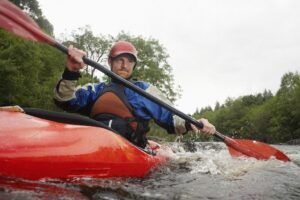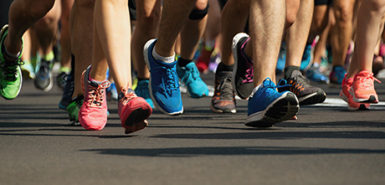
With winter weather winding down, and warmer spring and summer temperatures on the horizon, many are excited to get back into outdoor activities.
Boating and kayaking are often on the top of the list once the ice melts as many local rivers and streams never completely ice over.
However outdoor adventure seekers should take caution when they put in for the season’s first float.
Matthew Axtman, DO, is a sports medicine physician at Corewell Health in West Michigan and an avid kayaker.
He and his family have a lot of experience with cold water kayaking, so he shared some tips on how to be safe on the river.
Spring safety considerations
“Kayaking in semi-ice-covered creeks and rivers is very popular and a fun pasttime,” he said. “But it’s important to be prepared should any issues arise along the way.”
Dr. Axtman said river temperatures are often near freezing in early spring and even a few minutes in water that cold can be dangerous.
“The most important thing is looking at your environment and assessing safety risks,” Dr. Axtman said. “Now is the time when rivers are rising and snow is melting, making some of these rivers move a lot quicker.”
He said to be aware of water flow, river speeds and weather conditions before planning a kayaking trip as it is easy to quickly get caught up in fast moving water, especially early in the season.
If you have not been kayaking since last season, expect to come upon trees that fell over winter, he said.
“You will see a lot of downed trees in the water, so be cognizant of your surroundings. Many things could have completely changed from the last time you were on that same river.”
He said bringing an experienced kayaker along for your first ride is a good idea.
And take it slow at first.
“Be comfortable with who you are kayaking with,” he said. “If you’re a seasoned kayaker, don’t bring a novice along on a fast or high river.”
A frightening experience
Dr. Axtman said a couple years ago he was out with his wife and children on the Rogue River and had a very scary near-death experience.
“The water was high and moving quick,” he said. “As we were coming around a bend, there was a huge tree down that was blocking about 85 percent of the river. We had to book it over to the other side of the river and ended up hitting the tree and completely tipping our kayak.”
He and his wife quickly grabbed on to one of their daughters.
“I got knocked off, went underneath the kayak, and floated quite a way down the river,” he said. “Our two other daughters made it to the side safely while my wife dislodged the kayak and made her way to the side as well.”
“I was about 100 yards downstream and ended up losing a shoe, sunglasses, a hat and a phone.”
Dr. Axtman said he and his family were all completely soaked and very cold.
“Unfortunately, we still had a long way to go to the end, but we made it safely with no more obstacles.”
Dr. Axtman said it was a rough day on the river and another group ended up stuck at the same spot later in the day.
He said that rivers are flowing at a quick pace in the early spring months.
“I’m an experienced swimmer and kayaker and I couldn’t even get upriver when my kayak capsized,” he said. “You would rather come out having your life.”
Tips from a professional
Dr. Axtman stressed the importance of lifejackets and said it is a good idea to physically wear your lifejacket in spring versus just carrying it along.
“No matter your experience level, or how shallow the water might be, bring life jackets.”
Let someone know if you are going out for a longer trip – tell them where you are leaving and when you should return. He also said bringing a partner along can be helpful.
“Have someone at your side … another set of eyes,” he said. “You are watching them, and they are watching you.”
It is not a great idea to try solo kayaking in cold weather, he said.
He also said to look at how long you’re going to be gone and monitor the weather.
“Is your trip just a quick couple miles? Or ten miles?” he said.
Be prepared for an emergency. Bring a first aid kit, even just a couple band aids in a Ziplock bag.
Take at least one phone along in case of emergency–and keep it safe in a Ziplock bag attached to the kayak.
He said it is also important to dress for the cold weather and for temperatures that are 20 degrees warmer than it is outside.
“As you exercise, your heart will pump faster, you’ll get warmer and your core temp will increase,” he said. “Wear layers so you can adjust when temperatures change.”
Dr. Axtman also said to wear layers of clothing to adjust to body and outdoor temperatures, including moisture-wicking clothing–a shirt that can take moisture off your body and expel it into the environment
“This will help when the cold air hits. For example, a cotton shirt will hang on to water, and as cold air hits, it will bring down your temperature.
Also bring water to stay hydrated and pack a snack or energy bar to replenish energy along the way.
He said a lot of people think paddling is just an arm workout, but you can work up a good sweat kayaking.
It’s also a great activity for someone with arthritis or pain in the hip, knee or lower body.
“It is a no impact activity where you can get a really good workout in using your arms, shoulders, core and trunk,” he said. “Kayaking is a very nice cardiac workout that will get your heart rate up and impact upper body strength.”
 /a>
/a>
 /a>
/a>
 /a>
/a>